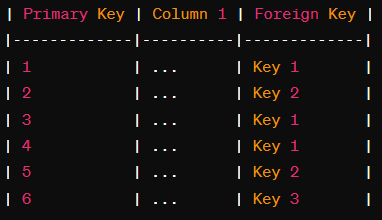How to Select the Last Records in a One to Many Relationship using SQL Server
Last Updated :
27 Feb, 2024
In database management, one-to-many relationships are common, where a record in one table can correspond to multiple records in another table. When dealing with such relationships, it’s often necessary to select the last records from the “many” side for each record on the “one” side.
In this article, we’ll explore how to achieve this using different approaches and their examples too.
How to Select the Last Records in a One-to-Many Relationship?
One-to-many relationships signify that each record in one table can correspond to multiple records in another table. For instance, consider two tables A and B, where the Primary key column of A is referenced as a Foreign key in B.
To efficiently select the last records from such relationships, we employ SQL Server joins. Below is the method that helps to select the last records in a one-to-many relationship using SQL Server as follows.
- Using Subquery with LIMIT and ORDER BY
- Using Subquery with Max Aggregate Function and GROUP BY
- Using o-related Subquery
- Using Left Join Logic
Let’s set up an environment to select the last records
To understand How to select the last records in a one-to-many relationship using SQL Server we need a 2 table on which we will perform various operations and queries. Here we will consider a table called Table A and Table B which contains. Here Table A contains Primary Key, Column 2, Column 3 and Table B contains Primary Key, Column 1, Foreign Key as Columns.
--create Table A
create table [Table A]{
[Primary Key] varchar(10) Primary Key,
[Column 2] varchar(10),
[Column 3] varchar(10)
}
--create Table B
create table [Table B]{
[Primary Key] varchar(10) Primary Key,
[Column 1] varchar(10),
[Foreign Key] varchar(10) Foreign Key references [Table A](Primary Key)
}
--insert into the Table A
insert into [Table A] values ('Key 1', 'D1', 'D4'), ('Key 2', 'D2', 'D5'), ('Key 3', 'D3', 'D6');
--insert into the Table B
insert into [Table B] values ('1', '...', 'Key 1'), ('2', '...', 'Key 2'), ('3', '...', 'Key 1'), ('4', '...', 'Key 1'), ('5', '...', 'Key 2'), ('6', '...', 'Key 3');
Our Table A Looks Like:

Table A
Our Table B Looks Like:

Table B
Now, execute the below query to get One-to-Many relationship between Table A and Table B in a single tabular form.
SELECT * from [Table A] A join [Table B] B on A.[Primary Key] = B.[Foreign Key];
Output:

Join of Table A and B
1. Using Subquery with LIMIT and ORDER BY
Here we will add a subquery that will look for the last record match in Table B for every record in Table A with ORDER BY Descending and LIMIT options
SELECT *
FROM [Table A] A
JOIN [Table B] B ON A.PrimaryKey = B.ForeignKey
WHERE B.PrimaryKey = (
SELECT PrimaryKey
FROM [Table B]
WHERE ForeignKey = A.PrimaryKey
ORDER BY PrimaryKey DESC
OFFSET 0 ROWS FETCH NEXT 1 ROWS ONLY
);
Output:

Last Records with Subquery with LIMIT and ORDER BY
2. Using Subquery with Max Aggregate Function and GROUP BY
Here we will add GROUP BY clause on TableA.PrimaryKey to the join select statement between Table A and Table B and pick the Max per group
SELECT MAX(A.PrimaryKey) as PrimaryKey, MAX(A.[Column 2]) as [Column 2], ...
FROM [Table A] A
JOIN [Table B] B ON A.[PrimaryKey] = B.[ForeignKey]
GROUP BY A.PrimaryKey;
Output:

Last Records with with Max Aggregate Function and GROUP BY
3. Using Co-related Sub Query
Here, we will return the record that matches with MAX PrimaryKey in Table B in Sub Query
SELECT A.*, B.*
FROM [Table A] A
JOIN [Table B] B on A.[PrimaryKey] = B.[ForeignKey]
WHERE B.PrimaryKey = (
SELECT MAX(PrimaryKey)
FROM [Table B]
WHERE ForeignKey = A.PrimaryKey
);
Output:

Last Records with Co-related Sub Query
4. Using Left Join Logic
Here we will use Left join Table with 2 Table B and for second left join we will add an extra condition as records with PrimaryKey Column in 3rd table of Join sequence should be greater than PrimaryKey Column of 2nd Table ie. Table B. This create some NULL records in 3rd used table which becomes our output.
SELECT A.*, B.*
FROM [Table A] A
LEFT JOIN [Table B] B ON A.PrimaryKey = B.ForeignKey
LEFT JOIN [Table B] C ON A.PrimaryKey = C.ForeignKey AND B.PrimaryKey < C.PrimaryKey
WHERE C.PrimaryKey IS NULL;
Output:

Conclusion
In conclusion, SQL Server offers several methods to select the last records in a one-to-many relationship. Whether using subqueries, aggregate functions, or left join logic, these approaches provide flexibility and efficiency in fetching the desired data. Understanding these techniques enables database managers to effectively handle such relationships and retrieve the most relevant information for their needs.
Share your thoughts in the comments
Please Login to comment...